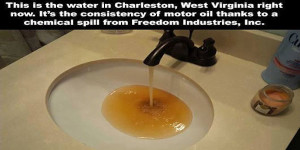
By Michelle Tinkham, staff writer for Save The Water™ | February 27th 2014.
West Virginia Chemical Spill Health Risks
In January, another dangerous risk to our water supply emerged in West Virginia. A small company, Freedom Industries Inc., was deemed responsible for a spill of two coal-cleaning chemicals that left nearly 300,000 people without clean water.¹ As a result of nearly 20 lawsuits from those affected, the company has since filed for bankruptcy and will shut down after the clean-up process is complete.¹ One of the claims in the lawsuits relate to healthcare risks associated with the two chemicals which were detected in the drinking water: 4-methylcyclohexane methanol (MCHM) and Triphenylphosphorous (PPH). Both of these compounds are used to wash coal and according to an article in Scientific America, very little is truly known about the long term health consequences of exposure since both are used primarily in industrial settings, not consumer products.²
How dangerous are the chemicals involved
MCHM is a colorless liquid chemical that should not be swallowed and is only listed as potentially causing eye, skin, and respiratory tract irritation from exposure. Per its Material Safety Data Sheet (MSDS) ³, it is poisonous but poses no other health risks for humans. This could be due in part to the lack of study on the chemical. Although, in testing at large doses, it did kill rats and half the minnow population of the Elk River where it was spilled.²
The second chemical involved in the spill, PPH, was discovered later. Its acute exposure effects are similar to that of MCHM: respiratory tract irritation such as cough and sore throat, as well as pain and redness to eyes and skin.⁴ But the MSDS sheet for this chemical also shows nerve damage as a possible effect from chronic exposure such as loss of coordination, tremors and muscle weakness.⁴ What is more disturbing is this particular chemical is not one listed in the Safe Drinking Water Act that water companies have to include in testing.⁵
Even through the clean-up process seems to be progressing well and the “do not use” order has been lifted, the Center for Disease Control (CDC) is still urging pregnant women to avoid contact until all traces of the chemicals are erased. ⁵ This order came after other residents were told that the tap water was safe. The CDC made a statement that no adverse health concerns were expected and the advice is being given simply to err on the side of caution.⁶ This is again due to the lack of research on the long-term consequences of exposure to these chemicals, especially for fetuses. This caution on the part of the CDC is causing some to question whether the water is truly safe for other residents as well.
According to CNN, at a recent town hall meeting of approximately 200 people, only 1% stated they were drinking the water despite it being deemed safe⁷. This has led to a request from the West Virginia governor to the federal government that these chemicals receive more research as soon as possible regarding long term health effects⁷. Even though there is no evidence of long-term risk at this time, this concern, especially for pregnant women, should be considered.. The CDC has deemed that water pollution at Camp Lejeune in North Carolina may be linked to birth defects, such as spina bifida and development of cancer in children, such as leukemia.⁸
Sadly these incidents are not isolated and hopefully will show us all how essential it is to protect our water and push for further research into the 1000s of chemicals that already exist in it as well as the expansion of the Clean Water Act. Additional research is needed to determine whether the chemicals released in the West Virginia spill and others pose any long term health hazards and to simply calm the fears of residents exposed to them. Once true risks have been assessed, proper containment procedures can be determined and enforced for the protection of all involved and the preservation of one of our most precious resources- our surface water.
References
1. Brickley, P. (2/21/14) Company Linked to West Virginia Chemical Spill to Shut Down Operations. U.S. News. https://www.theguardian.com/us-news/2015/jan/16/west-virginia-chemical-spill-new-firm-safety-violations Accessed Feb 22, 2014.
2. Biello, D. (1/10/14) How Dangerous Is the Coal-Washing Chemical Spilled in West Virginia? Scientific American. https://www.scientificamerican.com/article/how-dangerous-is-the-chemical-spilled-in-west-virginia/ Accessed Feb 22, 2014.
3. Eastman. (10/19/05) Material Safety Data Sheet- Crude MCHM. http://mediad.publicbroadcasting.net/p/wvpn/files/201401/MSDS-MCHM_I140109214955.pdf Accessed Feb 22, 2014.
4. Stream Chemicals Inc. (8/17/11) Material Safety Data Sheet- Triphenylphosphine, 99%. http://www.strem.com/catalog/msds/15-6700 Accessed Feb 22, 2014.
5. Shogren, E. (1/24/14) Drinking Water Not Tested For Tens Of Thousands Of Chemicals. https://www.npr.org/sections/thesalt/2014/01/24/265520673/drinking-water-not-tested-for-tens-of-thousands-of-chemicals Accessed Feb 22, 2014.
6. Wunderground.com. (1/16/14) Pregnant Women in West Virginia Told to Avoid Water. https://www.wunderground.com/news/pregnant-women-west-virginia-told-avoid-water-20140116
Accessed Feb 22, 2014.
7. Cohen, E. Watkins, T. (2/20/14) West Virginia asks feds to study possible health effects of chemical spill. CNN. https://www.cnn.com/2014/02/19/health/west-virginia-water/ Accessed Feb 22, 2014.
8. Twedell, K. (12/6/13) Camp Lejeune water contamination linked to birth defects. https://www.scientificamerican.com/article/camp-lejeune-water-contamination-li/ Accessed Feb 22, 2014.

